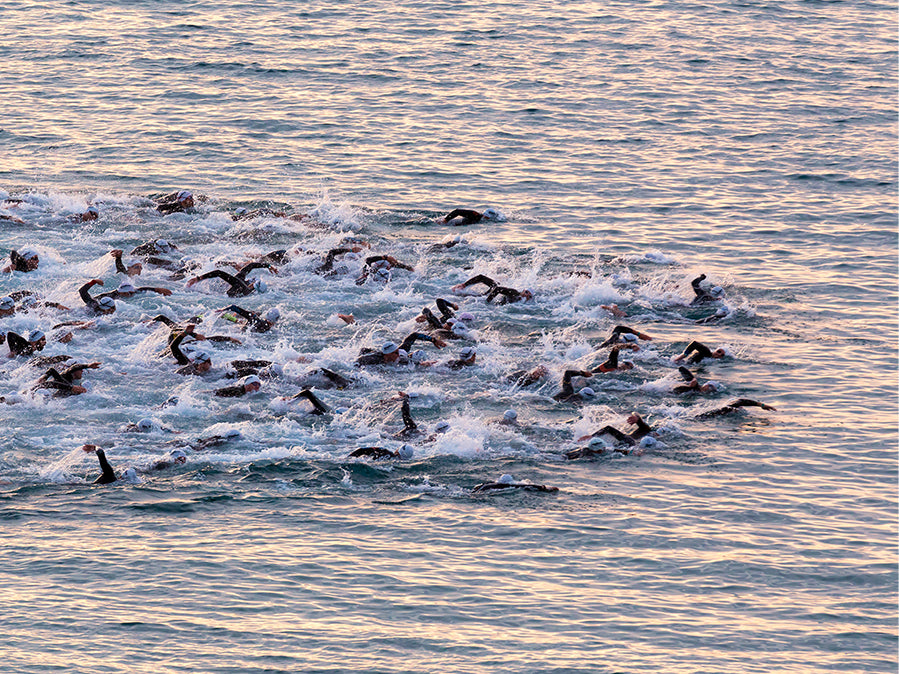Swimming Strokes and Techniques for Triathlon
For many, the swimming part of your triathlon may be the most challenging. Using the right triathlon swimming stroke can help you finish better and increase your endurance.
Unlike swimming in a calm pool, most triathlons take place in the open water with hundreds of other swimmers. This is why your triathlon swimming stroke is so important.
Remember, it's not only about speed in the swimming part of your race. Proper technique and form will help propel you forward more efficiently with less effort. Today we're going to look at which combination of triathlon swimming strokes you should master and use during your race.
Best triathlon swimming strokes
Athletes can use any triathlon swimming stroke or technique they wish. These include treading water or floating, which are useful skills to have in open water swimming where there are no lane ropes or solid objects to hold on to for rest.
Because the swim portion's goal is to work less and swim more efficiently, freestyle is usually recommended for the entire race and is also the fastest stroke.
Here are the triathlon swimming strokes we recommend knowing for your swim:
Freestyle (Front crawl)
Hands down, freestyle is the best stroke to use when swimming in a triathlon. It is the fastest, most efficient stroke. The freestyle stroke not only allows you to move swiftly while helping you get your bearings from side to side to check for buoys or other swimmers around you.
When using freestyle swimming as a triathlon swimming stroke in open water, your catch, pull, body rotation, and breathing will stay the same. However, here's how to adapt your pool-style freestyle technique for open water:
- Sighting: Instead of sighting based on pool lines under the water, practice sighting straight forward at a buoy or landmark every 6-10 strokes.
- Stroke rate: Battling waves and chop is more manageable when you glide less, hold a high tempo, and create rhythmic strokes timed with waves in open water swims.
- Hand entry: You will need to practice more assertive hand entry to punch through the chop.

Here are five swim tips for triathlons to keep in mind:
- Relax: Don't try to fight the water. Use your energy to move your body forward instead.
- Spine: Align your spine as if you are on land, standing up tall and looking straight ahead.
- Glide: Separate each stroke with a short glide.
- Rotate: When rotating in the water, your torso should never go past 45% on either side and keep your head and lower legs steady.
- Arms: Keep your hand entry shoulder-width apart.
Treading water
As previously mentioned, treading water is a valuable skill, especially for long, open water swims. You may need to pause for a number of reasons, to take a break, calm yourself down, or to sight in especially choppy water. Treading water involves keeping your head above water while swimming in an upright position and is an essential skill for water safety. In an emergency, the ability to tread water and stay afloat without expelling too much energy will be key. It also allows you to remain calm and collected in challenging situations.
Breaststroke
Breaststroke is a popular stroke for competitive swimming, but it's also one of the slowest. It's a good triathlon swimming stroke to use when you need to rest or recover while still moving forward in the water. It also helps you get your bearings if you get disoriented, and because your head is above water, it allows for easy sighting.
Breaststroke is an excellent alternative to stopping in the water when you need to rest. With so many swimmers near each other, it's easy for even an experienced triathlete to become overwhelmed. Instead of stopping and treading water to reset, you can keep moving with breaststroke while you catch your breath and get your bearings.

Tips for improving your breaststroke
Many swimmers have a strong freestyle but struggle to perfect their breaststroke. Follow these best practices to improve your form and generate more power from your stroke:
- Never compromise stroke length for speed (you may rush your extension when you try to go too fast).
- If your stroke is not fast enough, raise your hips, adjust your leg and arm timing, raise your elbow, stop with your hands under your chin, and/or don't pull your knees up as high when you kick.
- When swimming in a wetsuit, focus on your arm and shoulder movements, don't bring your knees up during the kick, and keep your hips high in the water.
- Focus on correct breaths and timing (breathe in during in-sweeps of arms and out as hands extend forward)
- When practicing individual stroke components, always return to the full stroke before the end of your workout to ensure complete muscle memory.
Backstroke
Depending on the event, backstroke may not be permitted, so it's best to check with the race host to be sure. For example, USA Triathlon events allow backstroke, while Great Britain Triathlon generally does not.
If you do decide to use backstroke, there are a few things to keep in mind. When in a pool, you can generally use patterns on the ceiling or other markers to help you swim in a straight line. Out in the open water, this is more challenging and could result in a collision with another swimmer. Also, in a triathlon swim, rolling on your back is usually a sign of distress and may signify that you are struggling or in danger. We suggest using backstroke sparingly when you need a break.
Butterfly
Although Butterly may be a popular choice for pool swimming, it is not a choice that most would go for when swimming a triathlon due to the energy and intensity it demands to perform it well. In a triathlon setting, endurance is vital, so we recommend opting for a different stroke.
How to improve your triathlon swim
There are six ways to improve your swim. Focus on proper form for the following parts of your stroke:
Proper body position
Improving your body alignment is the best way to decrease drag. Refining your body position leads to a more effective swimming stroke—improving power, endurance, and speed. Proper body position includes making your body as long as possible and floating parallel to the ground, as well as a fixed head positioning. Practice keeping your gaze downward with a long, relaxed neck.
Hand entry and timing
Proper contact with the water helps you get a good catch of the water and minimizes shoulder strain and unnecessary movement. Your hand should draw a line from your side around and into the water, in line with your shoulder. It is crucial to ensure your hand entry is not too wide or too narrow and fully extend your arm when entering the water.

The timing of your torso, arm, and leg movements are important to cut down on unnecessary drag. When swimming, be sure to focus on your rhythm. Good timing leads to better balance, less energy spent, and ultimately, a faster swim.
The Catch
In addition to hand entry, your swim catch is a crucial element of the freestyle. When your hand enters the water, your fingers should be outstretched, pointing forward. Then when you initiate your pull, hinge at the elbow, not the wrist. This increases the surface area available to 'catch' the water and pull it behind you.
Breathing
Proper breathing while swimming is imperative to improving your swimming technique and form. Bad breathing not only fatigues your body faster but adds resistance, slowing you down. Your swimming breath technique will depend on a few factors, including which stroke you are swimming and whether you are in a sprint or long-distance race. For example, strokes like butterfly and breaststroke require a breath between each stroke, while with freestyle, you can breathe every few strokes.
Stroke count
Focusing on your stroke count while swimming is a great way to improve. By aiming to swim the same pace at a lower stroke count, you will become more efficient over time. You can also practice increasing and decreasing both stroke rate and distance per stroke until you find your sweet spot for both.
Tech to improve your triathlon swimming strokes
Many athletes struggle to count strokes and pay attention to their form at the same time. FORM Smart Swim Goggles are the only wearable swimming technology that gives you real-time data through augmented reality. It helps you quantify your swimming and makes you think about technique and finding your sweet spot.
You can use the FORM goggles when both training or on race day to help you swim to your ability and stay informed during your swims. Learn more about how FORM goggles can help you in open water swims.










